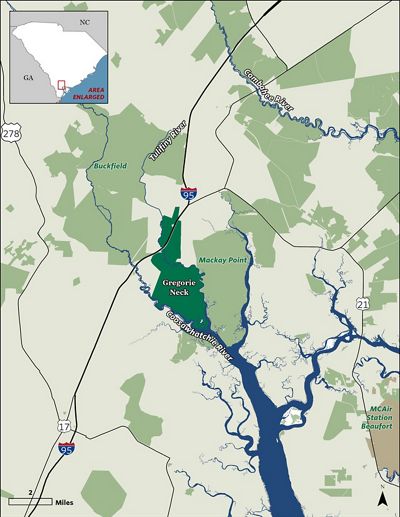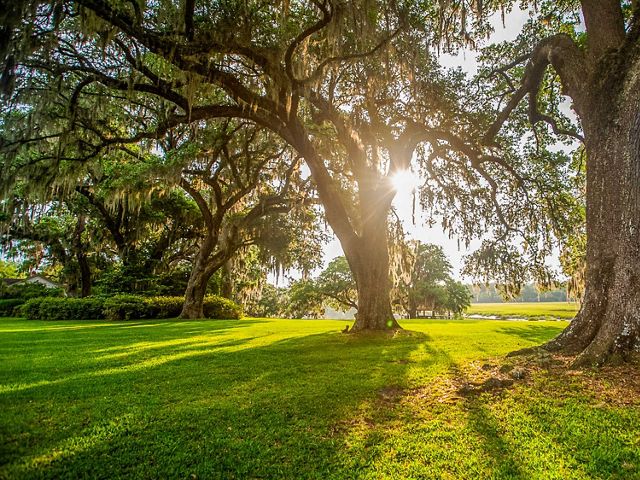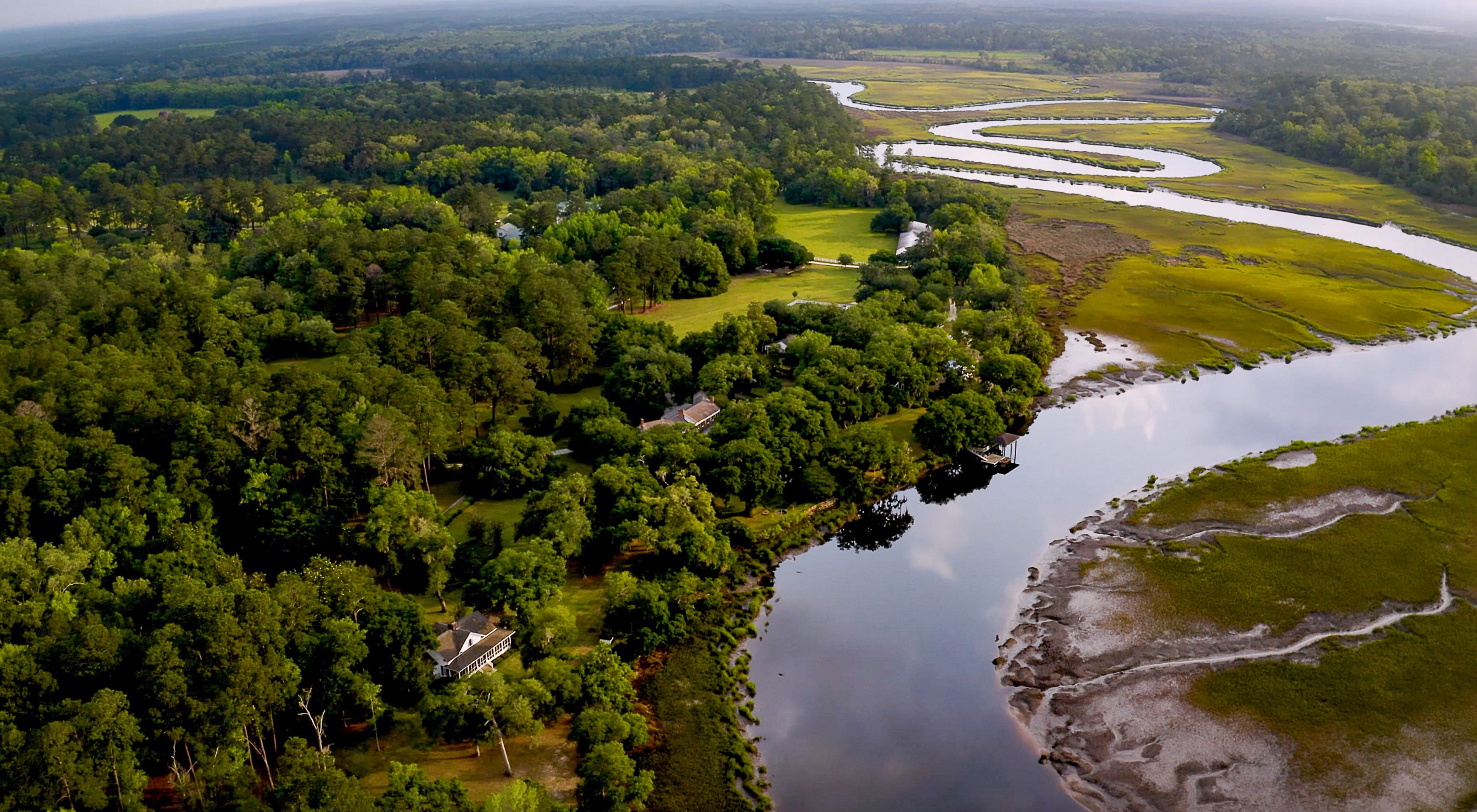Future of Massive Waterfront Property Now Certain
The Nature Conservancy Acquires, Works with Partners to Protect Jasper County’s Gregorie Neck
Media Contacts
-
Jennifer Howard
Steward Terra Communications
Phone: 843-709-4192
Email: jen@stewardterra.com

The Nature Conservancy announced the acquisition of one of the largest undeveloped waterfront properties in coastal South Carolina. Flanked by deep water access on the Coosawhatchie and Tulifiny Rivers and bisected by Interstate 95, the future of the 4,409-acre Gregorie Neck property became uncertain when it was listed for sale in 2023. In addition to the acquisition, TNC will also ensure the property will be permanently protected with a conservation easement.
“This region is experiencing such intense growth; when we saw the opportunity to protect a property like this – with so much water frontage and direct interstate access – we knew we had to make it happen,” commented Dale Threatt-Taylor, TNC's executive director in South Carolina. “Developing Gregorie Neck would have had a huge impact on this region’s nature and wildlife, as well as its infrastructure needs and traffic. Instead, we hope this project now will accelerate regional land protection efforts. This closing is an achievement made possible by a conservation-minded seller, creative real estate professionals and committed funding partners.”
This announcement comes as a moratorium on new commercial and residential development in Jasper County is temporarily in place, yet about to expire.
Quote: Dale Threatt-Taylor
This closing is an achievement made possible by a conservation-minded seller, creative real estate professionals and committed funding partners.
The Landscape
Gregorie Neck, named for Alexander Gregorie who acquired the property in 1798, has been managed for the last 30 years by the Jepson family to promote the property’s vast conservation values. Upland forests boast massive pines and hardwoods that have not been harvested in many decades. Impoundments along the rivers’ edges provide critical habitat for wading birds and migratory waterfowl. Open agricultural fields support livestock and songbirds.
“The variety and condition of Gregorie Neck’s ecosystems are remarkable,” commented David Bishop, PhD, coastal and midlands conservation director, The Nature Conservancy in SC. “But even more significant is how this property fits into the growing green band connecting the undeveloped lands in the Savannah River Basin with those in the ACE Basin. That band is under intense development pressure and is critical to protect water quality in Port Royal Sound and ensure wildlife have enough healthy habitat.”
To the east of Gregorie Neck, across the Tulifiny River, is Mackay Point, 6,736 acres under conservation easement with Lowcountry Land Trust. To the northwest is the 12,000-acre Buckfield assemblage, protected by The Nature Conservancy and Open Space Institute.
The property had been listed by Charleston-based Holcombe Fair & Lane. Charles Lane, broker-in-charge has championed many of coastal South Carolina’s conservation successes reflected on the acquisition. “It was an honor to help broker this once-in-a-lifetime project. While all the partners deserve accolades, I especially commend The Nature Conservancy and the Open Land Trust for their steadfast commitment and the landowners for their unwavering land ethic and generosity.”
Notable History
Property and historical records reveal a portion of Gregorie Neck lies in the battlefield footprint of the Battle of Tulifiny, a Civil War battle fought during Major General Sherman’s March to the Sea. Fighting for the Union were an estimated 5,000 troops, including the United States Army, Navy, and Marines; and four regiments of Colored Troops. The Confederacy was represented by 900 men, including the entire Corps of Cadets of the South Carolina Military Academy (The Citadel), marking the only time that the entire student body of a U.S. college fought in combat.

Permanent Protection
TNC acquired Gregorie Neck for $35 million and has secured an agreement with Beaufort, S.C.-based Open Land Trust to place the property under a conservation easement. The easement will permanently limit development of the property to no more than six homesteads, each with a limited number of structures. Following the placement of the easement, TNC will divest of the property, including existing waterfront homes and outbuildings.
“Unlike so many miles of waterfront in our state, the future of Gregorie Neck now is certain,” remarked Threatt-Taylor. “The very limited development allowed by this approach will leave thousands of acres of marsh, woods and fields intact for wildlife and water quality.”
“Permanent land protection with a conservation easement will protect the over 13 miles of river frontage and the property’s rural character forever,” remarked Kristin Williams, executive director, Open Land Trust. “Today is a victory for landscape-scale conservation because this property is truly the heart of the Port Royal Sound, waters on which all of Beaufort and Jasper County depend, and the heart of the protected connected greenbelt around Beaufort, Jasper and our military bases.
Funding Partners
The permanent restrictions outlined in the terms of the conservation easement will decrease the property’s value, a loss that is largely offset by a diversity of funding partners through competitive grants. Earlier this month, the United States Department of Defense announced that the Gregorie Neck project was the recipient of a $6 million REPI Challenge grant, awarded to prevent incompatible development and protect landscapes in the vicinity of the Marine Air Corps Station Beaufort. REPI Challenge grants are competitive nationally; the award to OLT to protect Gregorie Neck is the first and largest of its kind in the Lowcountry; however, it follows over 20 years of successful partnership between Beaufort County, MCAS-Beaufort and the Open Land Trust, protecting thousands of acres through traditional grants.
Gregorie Neck’s massive waterfront footprint caught the attention of the property’s downstream neighbor, Beaufort County. “What happens in Jasper County matters to Beaufort County and what happens on Gregorie Neck has a direct impact on the water quality of Port Royal Sound,” commented Kristin Williams. OLT applied for a grant from the new Beaufort County Greenspace Program. Passed by voters in 2022, Beaufort County levies a one percent sales tax for land conservation and may spend those dollars outside the county boundary to the benefit of Beaufort County taxpayers. A grant of one million dollars was requested and recommended by committee and will be reviewed later in March.
Open Land Trust has also applied for funding from the SC Conservation Bank, a statewide program to fund land conservation projects of critical importance. Their funding request will be heard next month.
Over the next few months, TNC, OLT and the MCAS-Beaufort through the Department of the Navy will complete final easement reviews and close on the conservation easement to finalize the property’s permanent protection. TNC may retain or sell the property to conservation-minded buyers, all subject to the terms of the easement.
“We hope the protection of Gregorie Neck encourages other large landowners on the Port Royal Sound to work toward conservation outcomes,” remarked Bishop. “We have a rare opportunity to protect our natural resources and sense of place in the Port Royal Sound and encourage development in the right places. That opportunity closed a long time ago in other coastal communities.”
The Nature Conservancy is a global conservation organization dedicated to conserving the lands and waters on which all life depends. Guided by science, we create innovative, on-the-ground solutions to our world’s toughest challenges so that nature and people can thrive together. We are tackling climate change, conserving lands, waters and oceans at an unprecedented scale, providing food and water sustainably and helping make cities more sustainable. Working in more than 70 countries and territories, we use a collaborative approach that engages local communities, governments, the private sector, and other partners. To learn more, visit nature.org or follow @nature_press on Twitter.
